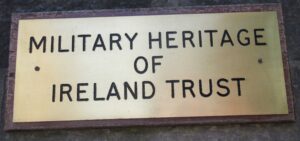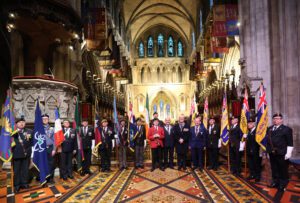1916 Ceremonial Commemorations – Easter 2016
A series of formal State ceremonial events took place over the Easter Weekend, remembering and honouring those who took part in the 1916 Rising, especially those who gave their lives. Óglaigh na hÉireann played a key role in all events. During 2016, the Defence Forces will participate in 56 ceremonial events throughout Ireland. Photographs courtesy of the Defence Forces Press Office.
Garden of Remembrance – 26 March

A ceremony for all who died during the Easter Rising was held in the Garden of Remembrance. In addition to the wreath laying ceremony, the event had a significant cultural element with appropriate music and readings.
The event commenced with a rendition of “The Parting Glass” by the Island of Ireland Peace Choir. Muriel Mc Auley, granddaughter of Thomas MacDonagh read a letter written by Padrick Pearse from Kilmainham Goal. Patricia Treacy, violin soloist with the Cross Border Orchestra of Ireland, performed “The Proclamation” by Patrick Cassidy. The Army Number 1 Band under the baton of Captain Fergal Carroll provided musical accompaniment throughout.
The Defence Forces provided ceremonial participation including a Motorcycle Escort of Honour for An tUachtarán, a Captain’s Guard of Honour, a Cadet Honour Guard, Lone Piper, and wreath bearers.
Glasnevin – 27 March
As a prelude to the principal State commemoration of the Easter Rising at Kilmainham Goal and the General Post Office, on Easter Sunday, a three-part wreath-laying ceremony occurred in Glasnevin Cemetery in the presence of Government and Diplomatic representatives.
The first ceremony took place at the Sigerson Monument for all who served during Easter Week and consisted of a reflection and the laying of wreaths by the Minister of Arts Heritage and the Gaeltacht and the British Ambassador to Ireland H.E Dominick Chilcott .
The second ceremony was at the grave of Edward Hollywood who was the weaver of the first Irish Tricolour in 1848, with the laying of wreaths by the French Ambassador H.E. Jean-Pierre Thébault, and Brigadier-General Joe Mulligan representing the Defence Forces.
The final ceremony took place at the grave of Peader Kearney who wrote the lyrics to The Soldiers’ Song later to be translated into Amhrán na bhFiann. Wreaths were laid by members of the Kearney family and by Mr John Green Chairman of the Glasnevin Trust.
Kilmainham Goal – 27 March

The ceremony took place in the Stone Breakers Yard on the site where the 1916 leaders were executed in Kilmainham Gaol. The ceremony included a solemn wreath-laying by the An tUachtarán. This was followed by a minute of silent reflection, a Piper’s Lament, the sounding of the Last Post, the raising of the National Flag to full mast, the rendering of Reveille and the playing of the Nation Anthem.
The Honour Guard consisted of personnel of the 92nd Cadet Class under the command of Captain Harmon.
Easter Parade – GPO – 27 March

Led by An tUachtarán, the wreath-laying ceremony at the General Post Office took place at noon. Having inspected a Captain’s Guard of Honour and the President laid a wreath on behalf of the Irish people in honour of all those who died in the Rising. Head Chaplain to the Forces, Rev Fr Seamus Madigan offered prayers and invited four children, representing the four provinces, to place flowers at the GPO.
The Piper’s Lament “Down by the Sally Gardens” was played by Bandsman Sean Maher. Captain Peter Kelleher read the Proclamation. Following, the sounding of the Last Post and Reveille, and the playing of the National Anthem, an Air Corps flypast of six Pilatus aircraft, and a marchpast of the combined Defence Forces Bands under the baton of the Director of the School of Music Lieutenant-Colonel Mark Armstrong, signalled the ceremony’s conclusion.
Dublin Parade – 27 March
The ceremonial parade on Easter Sunday through the streets of Dublin City Centre, involved 3,722 personnel from the Defence Forces, Emergency Services and Veterans’ Associations, with 78 vehicles, 17 Aircraft, Garda and Defence Forces Horses, as well as marching bands and flag parties.
The parade was under the command of Brigadier-General Michael Beary, General Officer Commanding 2 Brigade.
The marching elements comprised of personnel drawn from the Army, Air Corps, Naval Service, Reserve Defence Forces, Defence Forces Veterans, An Garda Siochána, Dublin Fire Brigade, Irish Prison Service, Revenue and Customs, the National Ambulance Service, St John’s Ambulance service, the Irish Red Cross, the RNLI, and Civil Defence.
The Battalion shortly to deploy to the Golan Heights, under the command of Lieutenant-Colonel Stephan Ryan, also participated. The marching elements were followed by a range of selected military vehicles and equipment, including armoured vehicles deployed on UN Peacekeeping Operations since 1960.
The ceremony concluded with the firing of a 21 Gun Salute by the 2 Artillery Regiment deployed in the Royal Hospital Kilmainham.

Synchronised Wreath Laying 28 March
Seven synchronised wreath-laying ceremonies were held in Dublin, with identical events taking place in Cork, Galway, Enniscorthy, Athenry and Ashbourne event at 1315hrs – the time that the first shots of the 1916 Rising were fired.
The locations in Dublin were: Moore St, National Archives (formerly Jacob’s Factory), City Hall, Boland’s Mill, The Four Courts, Royal College of Surgeons, St James Hospital (South Dublin Union).
The Defence Forces provided appropriate ceremonial elements at each event in including Wreath Bearer parties, Flag Parties and Air Corps Fly-pasts. Elements also included a National Colour Party and Proclamation Reader at each Dublin location.
Photographs kindly provided by Patrick Hugh Lynch and The Defence Forces Press Officer
View our Flickr Image Gallery >>




